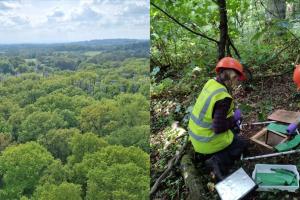
How Mature Trees Respond to Increased Atmospheric CO2
Recent research conducted at Bangor University provides valuable insights into the adaptability of mature trees in the face of rising atmospheric CO2 levels, a key concern associated with climate change. As greenhouse gases continue to accumulate, understanding how forests and individual trees respond is crucial for predicting future carbon sequestration potential and developing sustainable forest management strategies.
Scientists from Bangor University, collaborating with international partners and supported by the Natural Environment Research Council (NERC), have uncovered the mechanisms by which mature trees adjust to higher CO2 concentrations. Their findings reveal that these trees can modify their below-ground interactions—specifically, how they acquire nutrients—by adopting sophisticated strategies to sustain growth amid changing environmental conditions.
Bangor University’s Pioneering Research on Forest Carbon Dynamics
At the forefront of this research is the use of advanced experimental setups, notably the Free Air CO2 Enrichment (FACE) experiment located at the University of Birmingham’s Institute of Forest Research. This large-scale outdoor forest facility simulates future atmospheric conditions with over a third more CO2 than today’s levels, projecting what the environment might look like by the mid-21st century.
Researchers focused particularly on 180-year-old English oak trees, the backbone of many forests, by analyzing how they adjust over a five-year period under elevated CO2. The core discovery was that mature oak trees increase their root systems significantly—by approximately 73%—allowing them to explore more soil volume for essential nutrients. This ‘do-it-yourself’ approach ensures that trees can sustain their growth by directly sourcing nutrients from the soil, countering the potential nutrient limitations that could constrain their ability to act as carbon sinks.
Key Adaptive Strategies of Mature Trees to Elevated CO2
Enhanced Root Branching
The increase in fine root branching facilitates broader soil exploration. More extensive roots mean the trees can access nutrients over a larger area, compensating for any nutrient deficits caused by increased growth demands associated with higher CO2 levels.
Soil Microbial Interactions and Chemical Exudates
Beyond root expansion, the study unveiled intricate mutualistic relationships with soil microbes. The trees release small organic molecules that stimulate microbial activity, which in turn helps mobilize nutrients locked in the soil. Notably, there was a 63% rise in organic molecules released during spring and autumn, times when nutrient demands are heightened.
Furthermore, trees increase their symbiotic associations with root fungi by about 17%, enhancing nutrient exchange processes. They also alter the composition of root exudates, effectively outsourcing nutrient acquisition to the microbial community, a strategy that allows continued growth without depleting soil nutrients prematurely.
Implications for Climate Change and Forest Management
This research has significant implications for climate mitigation policies. Forests are vital carbon sinks, absorbing CO2 from the atmosphere through photosynthesis. Bangor University’s findings suggest that mature forests may continue to sequester carbon effectively by adopting these below-ground strategies, provided soil nutrients remain available.
However, a critical question remains: will the increased carbon investment into nutrient acquisition deplete soil nutrients over time? The ongoing experiments aim to determine whether nutrient supplies can sustain these adaptive strategies in the long term, which is essential for modeling the future capacity of forests to act as carbon sinks.
Policy and Practical Considerations
These mechanistic insights inform policymakers about the resilience of mature forests under climate change scenarios. Strategies that support soil health—including nutrient replenishment and sustainable forest management—are vital to maintain the balance between carbon sequestration and nutrient availability.
Additionally, forest conservation efforts should prioritize preserving mature trees and soils that support complex microbial ecosystems, which are integral to the adaptive processes observed. Such measures can enhance the resilience of forests and ensure their continued role in mitigating climate change.
Why This Research Matters for Future Climate Action
The ability of mature trees to adapt to higher CO2 levels through dynamic below-ground strategies offers a hopeful perspective amid climate concerns. It underscores the importance of understanding not just above-ground tree growth but also the critical subterranean interactions that sustain forests.
Bangor University’s research emphasizes that continued scientific investigation into forest ecology is essential. As policies like the Paris Agreement and the EU Green Deal aim for net-zero emissions, knowledge about natural carbon sinks’ resilience and limits informs effective climate strategies. Maintaining and enhancing soil nutrient cycles will be key to ensuring forests can continue to serve as vital carbon repositories in a warming world.
Next Steps in Research and Forest Conservation
The ongoing studies at BIFoR-FACE will explore whether soil nutrients can keep pace with the increased demands of trees under elevated CO2 conditions. This research will provide valuable data on soil nutrient stocks and help determine the sustainability of these adaptive strategies over decades.
For forest managers and policymakers, supporting research and sustainable practices that protect and enrich soil ecosystems will be essential. This includes practices such as minimal soil disturbance, organic amendments, and conserving microbial diversity, all aimed at fostering resilient forest ecosystems capable of adapting to future atmospheric conditions.
Conclusion: Bridging Science and Policy for a Sustainable Future
The discoveries from Bangor University advance our understanding of forest responses to climate change, highlighting the ingenuity of mature trees in managing nutrient and carbon dynamics. By fostering environments that support soil health and microbial partnerships, we can help forests adapt and continue to serve as crucial carbon sinks.
As climate challenges escalate, integrating science-driven insights into policy and land management will be vital. Supporting ongoing research and implementing practices that sustain soil nutrients can ensure forests remain resilient in an evolving climate, contributing effectively to global carbon mitigation efforts.
For those interested in learning more about forest ecology and climate adaptation strategies, explore programs at Bangor University or contact forestry and environmental science experts dedicated to advancing sustainable solutions.

